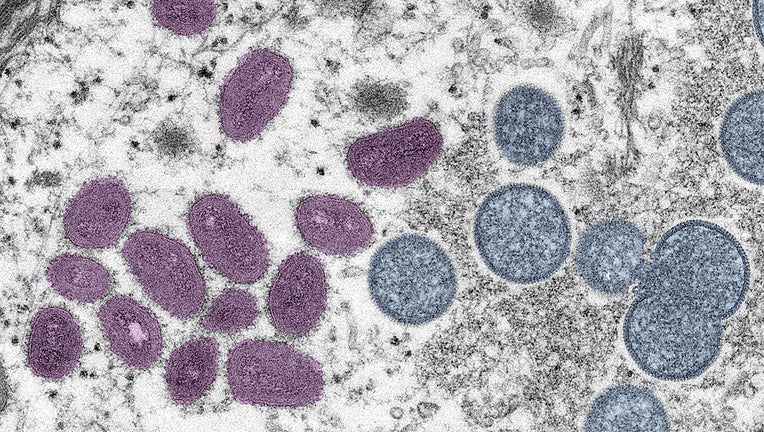Monkeypox in Minnesota: 2 cases now confirmed

Digitally-colorized electron microscopic (EM) image depicting a monkeypox virion (virus particle), obtained from a clinical sample associated with a 2003 prairie dog outbreak, published June 6, 2022. The image depicts a thin section image from a huma (Photo via Smith Collection/Gado/Getty Images)
MINNEAPOLIS (FOX 9) - Two cases of monkeypox have been confirmed in Minnesota as of June 28, according to the Minnesota Department of Health.
State health officials reported the first case of monkeypox in a Twin Cities adult on Monday. MDH says the first patient was likely exposed to monkeypox while traveling abroad. They are receiving outpatient care, and MDH is conducting contact tracing with local health partners to identify anyone who may be at risk due to direct close contact with the person while they were infectious.
The condition of the person with the second case of monkeypox hasn't been released.
"While the threat of monkeypox generally remains low, it’s important that everyone be aware of this disease, so that those at risk can seek medical care and get tested promptly if they believe they have symptoms," Minnesota Health Commissioner Jan Malcolm said on Monday.
Health officials say monkeypox doesn't easily spread between people with casual contact, but transmission can happen through contact with infectious sores and body fluids, contaminated items (clothing, bedding), or through respiratory droplets from prolonged face-to-face contact, including sexual contact.
The CDC, as of June 24, has reported 201 cases of monkeypox/orthopoxvirus in 26 other U.S. states. More than 4,100 cases have been reported in 47 countries where the disease is not typically reported. Over the last month, MDH has been working with health care providers and community partners to promote awareness of monkeypox, including what symptoms to look for, how to test for it, and ways to help prevent transmission.
Symptoms of monkeypox
RELATED: What is monkeypox?
The symptoms of monkeypox can include fever, headache, muscle aches, swollen lymph nodes, and a rash that can look like pimples or blisters. In this outbreak, some individuals have had a rash only and no other symptoms, and sometimes the rash consists of only a few sores. The rash can occur in the mouth, and there may be sores in the genital and anal areas. In other cases, a rash may be on the face and on other parts of the body.
The illness typically lasts two to four weeks and most people get better on their own without treatment. However, sometimes monkeypox can cause scars from the sores, lead to pneumonia, and in rare cases even be fatal.
People who have monkeypox can spread the virus from the time symptoms start until the rash has fully healed and a fresh layer of skin has formed.
Preventing spread of monkeypox
MDH says to prevent the spread of monkeypox, people should:
- Practice good hand hygiene. For example, washing your hands with soap and water or using an alcohol-based hand sanitizer.
- Minimize skin-to-skin contact with individuals who have been exposed to the virus or to those showing a rash or skin sores.
- Avoid contact with any materials, such as bedding, that has been in direct contact with someone with monkeypox.
- Reach out to a health care provider if you develop symptoms, as early recognition and testing can help prevent further transmission.
The need for a vaccine or antivirals is being evaluated on a case-by-case basis, in consultation with the CDC. The CDC doesn't recommend broader use of the vaccine at this time.

